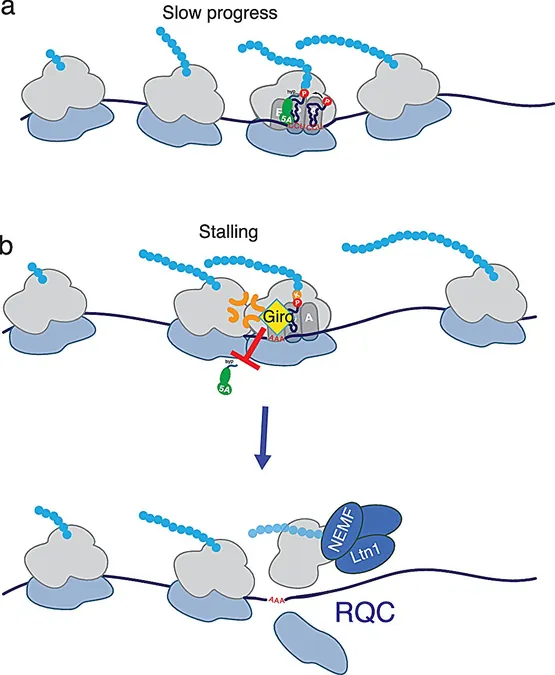
Unveiling the Secrets of Girolline: The Remarkable Compound from Sea Sponges That Could Change Medicine Forever!
2025-01-14
Author: Mei
Introduction
Scientists have made a breakthrough that could revolutionize our understanding of disease treatment by exploring a compound called girolline, derived from the sea sponge Pseudaxinyssa cantharella. This remarkable substance has already shown promise in fighting tumors and combating malaria, but recent research conducted by a dedicated team at the RIKEN Center for Sustainable Resource Science reveals intriguing new details about its mechanisms of action.
What is Girolline?
Girolline is not just another chemical; it’s a powerful compound that the sea sponge produces to defend itself against predators, showcasing the incredible biological ingenuity found in marine organisms. In fact, sea sponges are treasure troves of biologically active compounds, making them essential to modern medicine.
Previous Understanding and New Findings
For a long time, girolline’s potential antitumor effects were thought to stem from its ability to act as a general translation inhibitor, blocking the process that translates messenger RNA into proteins. However, the latest research published in the prestigious Nature Communications has uncovered a groundbreaking new mechanism that sets girolline apart.
Tilman Schneider-Poetsch, a lead author on the study, revealed, 'We discovered that girolline modulates the activity of a specific translation factor known as eIF5A. Unlike what was previously believed, it doesn’t just indiscriminately inhibit translation; it actually targets certain amino acid sequences!' This selective approach means girolline could be a game-changer in diverse fields, including cancer research, aging, and mitochondrial health.
Mechanism of Action
The researchers found that girolline interferes with eIF5A’s ability to assist ribosomes – the cell's protein production units – when translating difficult amino acid sequences. When eIF5A can’t bind to the ribosome, translation stalling occurs, leading to the degradation of incomplete proteins through a pathway known as ribosome-associated quality control (RQC). This mechanism of action might explain the toxicity of girolline to certain cancer cells.
Implications for Malaria Treatment
Interestingly, the sequences that trigger this stall include coding for amino acids like proline and lysine, particularly when the sequence encodes lysine with three consecutive adenines (AAA). This detail is particularly relevant in the context of treating malaria. The messenger RNA of Plasmodium falciparum, the malaria-causing parasite, often contains stretches rich in adenine, making these organisms potentially more susceptible to girolline’s effects.
Broad Applications in Medicine
The implications of this research extend beyond cancer and malaria. Given eIF5A's role in maintaining mitochondrial function, which is critical for cellular health and longevity, girolline could serve as a powerful tool in the study of aging and neurodegenerative diseases. Schneider-Poetsch confirmed, 'Girolline's selectivity opens new avenues to investigate eIF5A’s impact on aging and disorders linked to mitochondrial dysfunction.'
Future Directions
Researchers are already planning follow-up projects to delve deeper into the functions of girolline and its potential therapeutic applications, making this discovery not only a scientific milestone but a beacon of hope for future medical advancements.
Conclusion
Keep your eyes peeled as the story of girolline unfolds – this compound might just hold the key to fighting some of humanity's most pressing health challenges!

 Brasil (PT)
Brasil (PT)
 Canada (EN)
Canada (EN)
 Chile (ES)
Chile (ES)
 Česko (CS)
Česko (CS)
 대한민국 (KO)
대한민국 (KO)
 España (ES)
España (ES)
 France (FR)
France (FR)
 Hong Kong (EN)
Hong Kong (EN)
 Italia (IT)
Italia (IT)
 日本 (JA)
日本 (JA)
 Magyarország (HU)
Magyarország (HU)
 Norge (NO)
Norge (NO)
 Polska (PL)
Polska (PL)
 Schweiz (DE)
Schweiz (DE)
 Singapore (EN)
Singapore (EN)
 Sverige (SV)
Sverige (SV)
 Suomi (FI)
Suomi (FI)
 Türkiye (TR)
Türkiye (TR)
 الإمارات العربية المتحدة (AR)
الإمارات العربية المتحدة (AR)